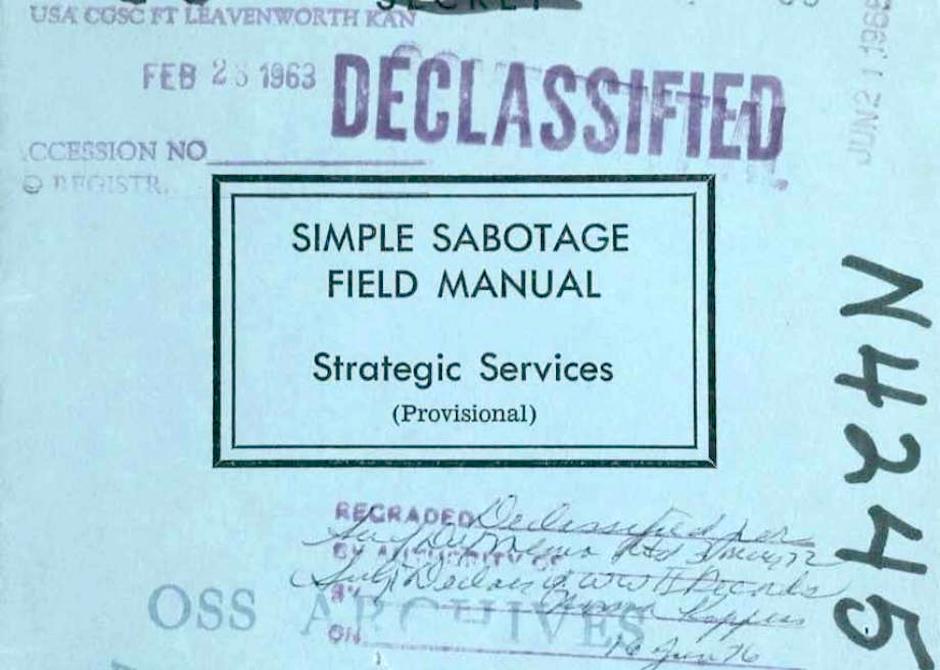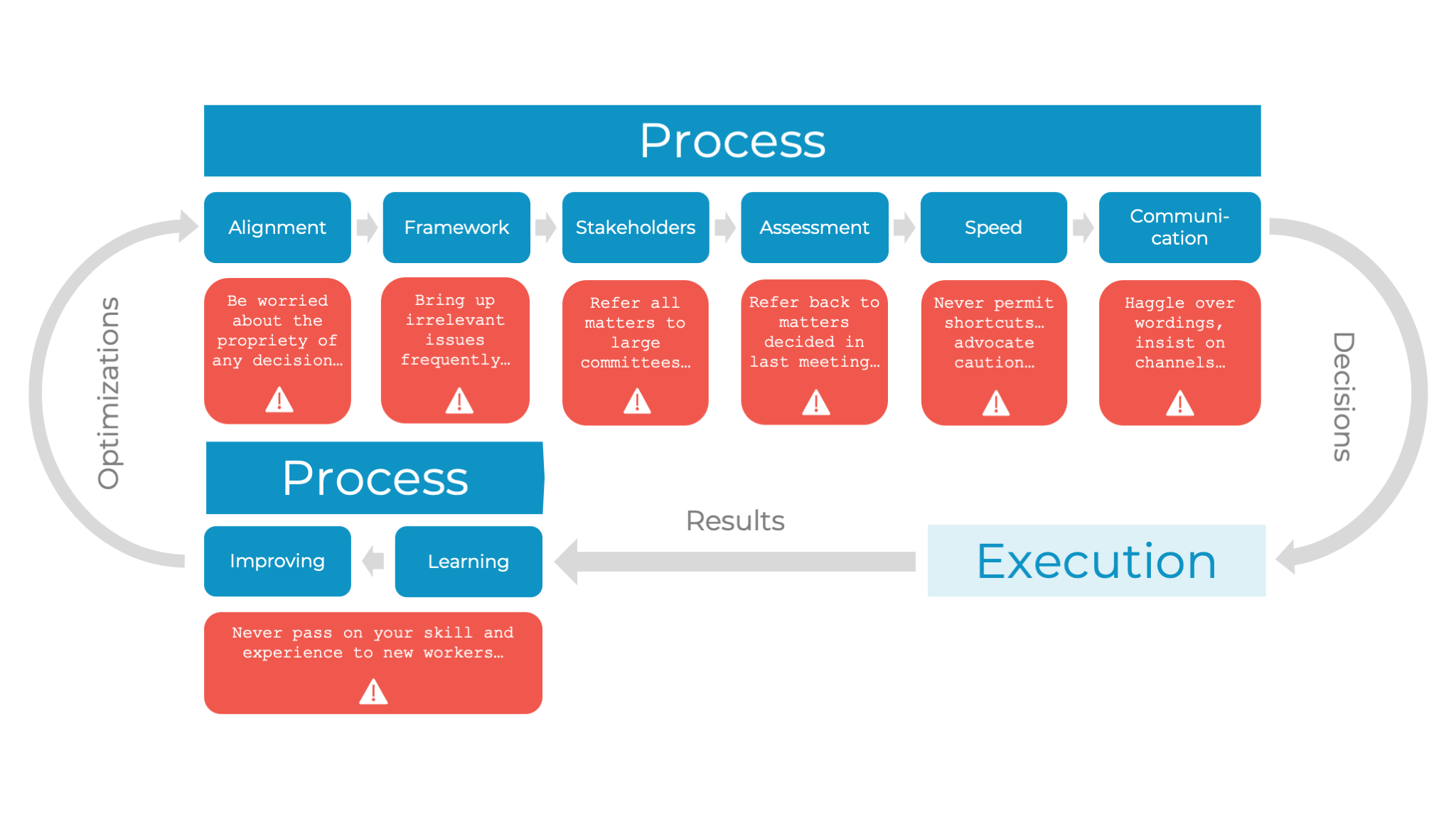A Spy’s Guide To Making Bad Decisions

In 1944, the federal government published a confidential manual called the Strategic Services Simple Sabotage Field Manual No. 3 as a practical guide to sabotage. Authored by the founding father of the CIA, William J. Donovan, the manual gave clandestine officers a simple, effective method to sabotage industrial production, interfere with transportation and communications, and, most interestingly, degrade organizations’ productivity from within.
How did the father of the most prolific spy agency in the world recommend degrading the productivity of an adversarial institution?
It’s simple – facilitate lousy decision-making.
Here’s an excerpt from the saboteur handbook’s recommendations.
General Interferences With Organizations And Production
- Be worried about the propriety of any decision – raise the question of whether such action as is contemplated lies within the jurisdiction of the group or whether it might conflict with the policy of some higher echelon.
- Bring up irrelevant issues as frequently as possible.
- When possible, refer all matters to committees for “further study and consideration.” Attempt to make the committees as large as possible — never less than five.
- Refer back to matters decided upon at the last meeting and attempt to re-open the question of the advisability of that decision.
- Haggle over precise wordings of communications, minutes, resolutions.
- Insist on doing everything from “Channels.” Never permit shortcuts to be taken to expedite decisions.
- Work slowly.
- Contrive as many interruptions to your work as you can.
- Do your work poorly and blame it on bad tools, machinery, or equipment. Complain that these things are preventing you from doing your job right.
- Advocate “caution.” Be “reasonable” and urge your fellow-conferees to be “reasonable” and avoid haste which might result in embarrassments or difficulties later on.
- Never pass on your skill and experience to a new or less skillful worker.
An investigative eye can see the pattern. All these tactics disrupt the decision-making process.
It’s not surprising that the founder of the CIA focused on decision-making as the weak point for organizational sabotage. A Bain survey of 800 large organizations found that the quality of decision-making within an organization has a 95 percent correlation with revenue growth, return on capital and shareholder return. Simply said, if you undermine the quality of decision-making, you undermine an organization's financial performance.
Corporate Sabotage By Lowering Decision IQ
I find it particularly striking how closely the sabotage strategies parallel the findings of our decision IQ research by impeding effective decision-making processes at every step.

Each decision IQ focus area has a specific set of common-sense activities and behaviors that contribute to overall decision effectiveness. The sabotage manual systematically details how a spy can disrupt enemy organizations’ decision-making at every step:
Alignment: There is precise alignment across values, goals and priorities to perform, innovate and grow over time. The culture supports effective decision-making and motivates people to make effective decisions that align well with business goals.
- Sabotage > Question decision propriety and jurisdiction.
Framework: Decisions are clearly framed, including important context and all key questions. Decisions also have a logical structure and flow, and people know how to find the data and analyses required to make decisions.
- Sabotage > Create confusion with irrelevancies.
Stakeholders: The right people are involved in decisions. Decision-makers incorporate input from stakeholders and give this input appropriate weight.
- Sabotage > Obfuscate and escalate decision rights.
Assessment: Before making a decision, people gather needed data and perform the right amount of analysis, neither shooting from the hip nor bogging down in analysis paralysis. Decisions involve the right amount of discussion, avoiding dictatorial decisions and death by meetings.
- Sabotage > Second-guess and over-analyze.
Speed: People are willing and empowered to make decisions as needed. They make decisions fast enough for any given situation, and their decisions stick once they are made.
- Sabotage > Never permit shortcuts, work slowly, interrupt work, complain, and be cautious.
Communication: Decisions are communicated clearly and quickly to everyone affected. Stakeholders and affected people support decisions even when they disagree.
- Sabotage > Haggle over wording and insist on “channels.”
Learning: People remember past decisions with clear records of how and why decisions are made. Decision-specific results are tracked to measure decision effectiveness over time.
Improving: Regular reviews or post-mortems are used to evaluate past decisions, and it is easy to find lessons learned from previous similar decisions. Bad decisions are quickly identified and fixed.
- Sabotage > Never pass on skill and experience.
These clever sabotage methods were designed to drive bad decision-making, low employee morale, and enemy institutions' inevitable degradation.
It Doesn’t Take A Super-Spy
It doesn’t take a James Bond-level saboteur to jeopardize an organization’s decision-making process. You probably recognize some of those sabotaging behaviors happening within your organization. They are not the results of a corporate espionage campaign from a sinister competitor. They are the well-intentioned, self-inflicted wounds of a large, complex organization.
In 1776, Adam Smith’s classic book, The Wealth of Nations, laid out the concept of ‘Division of Labor’ and what we would describe today as departments and functions with specialized capabilities like sales, marketing and operations. In the nearly 250 years since Smith published his book, executives and consultants have made fortunes innovating how work flows from function to function, also known as business processes.
These process innovations were fundamental to the rise of large corporations as we know them today. More effective business processes have significantly improved organizational efficiency, productivity, and scalability by streamlining workflows, reducing errors and standardizing procedures. They have also facilitated specialization, leading to enhanced expertise and higher-quality outputs.
However, organizational decision-making became much more complex as business processes became more intricate. This complexity inadvertently leads to problems that stifle progress and hinder decision-making:
- Loss of Agility: Complex organizations struggle to react quickly to opportunities or threats.
- Information Overload: Vast floods of information complicate identifying crucial data for decision-makers.
- Groupthink: Suppressed dissenting opinions lead to poor decisions and a lack of diverse thought.
- Lack of Accountability: Complex processes obscure responsibility, hindering improvement and learning.
- Resistance to Change: Intricate processes create inflexibility, obstructing the changes necessary to remain competitive.
Complex business processes are a source of immense daily frustration for employees and missed opportunities for companies. The many steps, layers of approvals and complex analysis requirements lead to delays, confusion and wasted effort. Employees get bogged down by minutiae that distract from their core responsibilities and meaningful contributions to strategic objectives. Convoluted processes stifle innovation and reduce decision quality, impacting employee engagement and organizational performance.
It’s time for corporate counter-espionage programs to overcome this self-sabotage. The next phase of organizational innovation must adapt decision-making processes to fit the needs of the 21st century, providing equal benefits for employees and organizations.
Download our free whitepaper to learn more about overcoming decision self-sabotage at your company.
